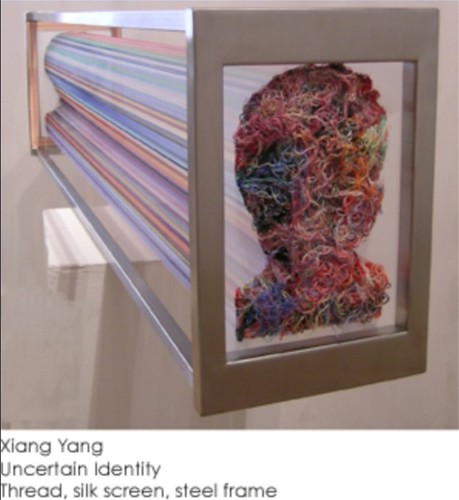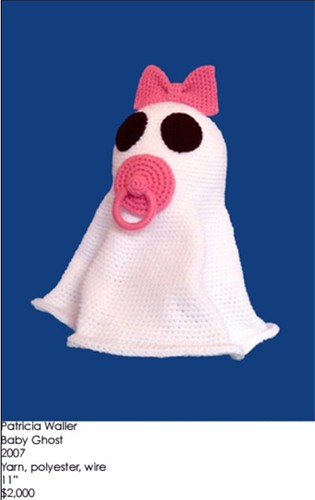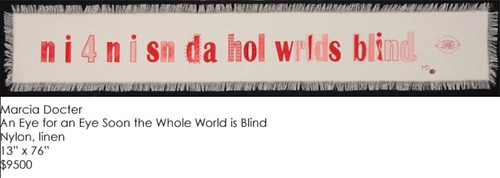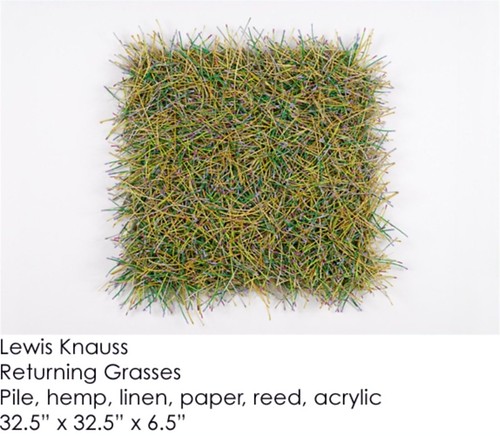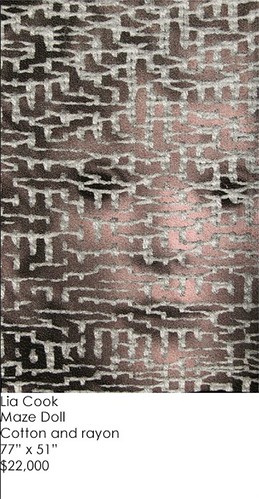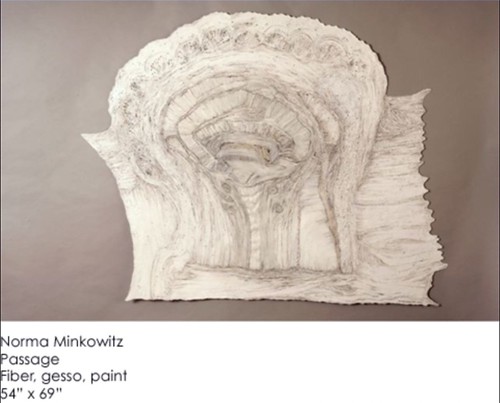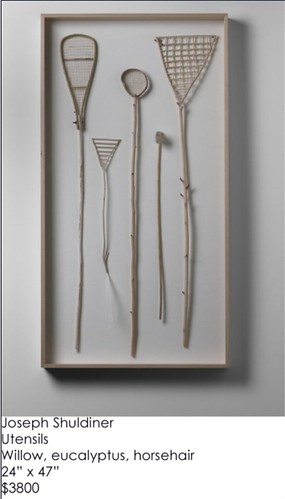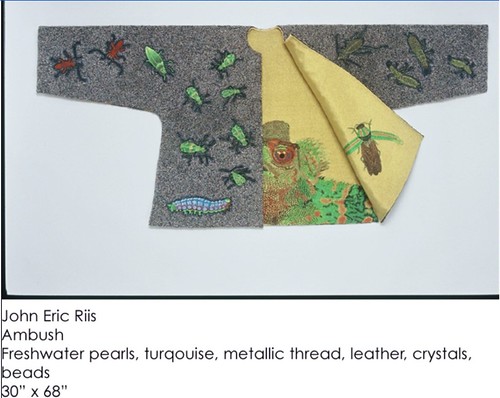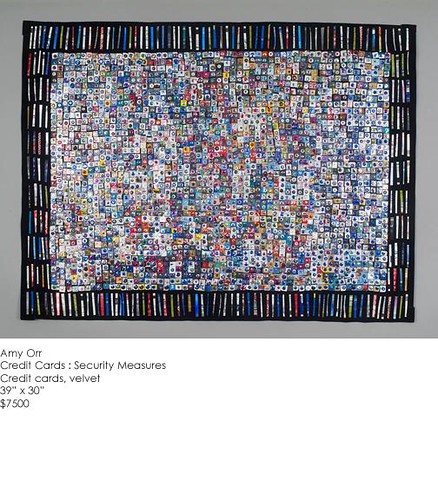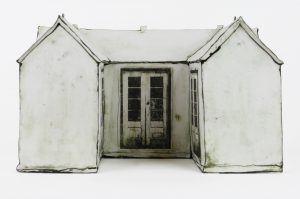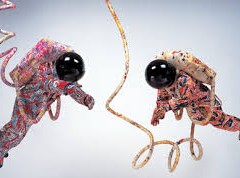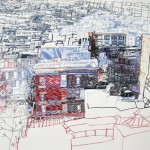This is the second of two posts on some fiber exhibits I saw. Here’s the first one.
6th International Fiber Biennial
Snyderman/Works Galleries
About 100 artists from far and wide were selected for this exhibit, now in its 6th year, curated by Snyderman Gallery director/exhibition curator, Bruce Hoffman. This show is the seed from which the full extravaganza of fiber exhibits in Philadelphia grew. The range of materials and methods is as astounding as ever, from quilted film to plastic discs arranged in a grid to suggest the grid of woven fabric. The craftsmanship was uniformly outstanding. Here’s what I found most interesting:
Xiang Yang‘s Uncertain Identity takes his two-faced embroidery frames to new limits. This Chinese-born artist, who used to live in Philadelphia, seems to be in the midst of wondering just how Chinese he still is, if I can read a bit of autobiography into this new piece. Xiang is now represented by Snyderman.
Susie Brandt‘s Beech Sampler unites good-girl stitchery with bad-boy tree carving and creates a love note to both practices–using neither the stitchery nor the beech tree. It’s a print on fabric.
Patricia Waller‘s Baby Ghost is my kind of kitsch. That the ghost would have a pacifier stuffed in its mouth, a big pink bow, and giant, innocent/scary black holes for eyes just strikes me as hilarious. Waller has it both ways–sentimental and not. Plus, it’s beautifully made. I also liked her crocheted bare lightbulb.
Marcia Docter‘s An Eye for an Eye Soon the Whole World is Blind, which is in the sampler tradition, is also a piece of political protest–in pinks. The warning, written as a rebus–or a text message–it is only for those who are sighted.
This little patch of grass took a lot of looking by Lewis Knauss. I realize the small scale was probably chosen partly because of the intense process, but that it’s a square patch and is so literal moves this piece into contemporary deadpan.
Lia Cook‘s Maze Doll, a computer generated tapestry of sorts, has a creep factor in the way the embedded doll’s face emerges slowly as the image behind the yucky maze, suggesting decomposition and neglect.
Everything by Joyce Scott pleased me, from this 3-D portrait of glass beads, Later Baby, to her necklaces. She’s fearless in her image-making and object making.
She’s a master of her medium and I wish one of those necklaces was mine.
Passage, by Norma Minkowitz, is a giant stitched drawing. It’s really hard to tell from this picture what the physical presence of this large piece is, but that small gray passage hole, with the maze of paths around it, goes in many directions at once–to death, to the cosmos, to the daily paths we follow, etc. etc. It’s also a little baroque, a little sexy, a little frilly and has a lot of quirky decisions in it.
Joseph Shuldiner‘s delicate “utensils” seem like people-surrogates to me. They are vulnerable and too tender for the task that lays ahead of them. Very nice.
Usually when insects are on clothes, they become quite decorative and lose their creep factor. Not here in Ambush, by John Eric Riis. These make me recoil. Excellent.
Ed Bing Lee has gone into high gear, turning out one knotted morsel after another, like this key lime pie, and a cupcake with sprinkles. The food must be selling for him, but I miss the variety he has previously brought to his intense process. It felt a wee bit like product this time.
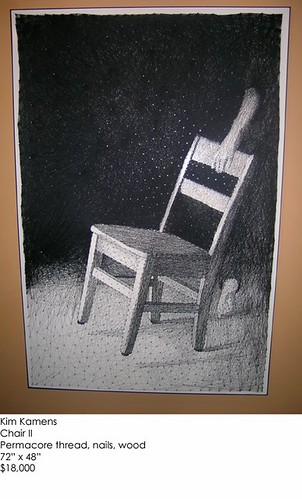
The noir mixed media thread drawing by Kim Kamens speaks of chair as body, of nails as stars as well as structural devices and of the kinds of shimmering quality of penumbral spaces. I liked the moodiness of the piece and the disembodied arm. But it got subverted by the foot in a way that undercut the mystery.
Kamens’ methodology reminds me of Mark Khaisman’s packing tape drawings.
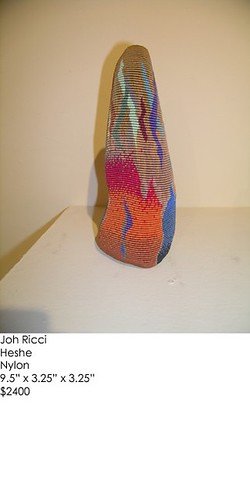
Joh Ricci’s lumpy stele is a Weeble and quite human.
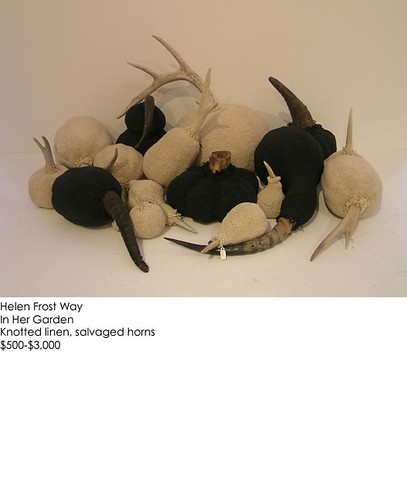
In her Garden, Helen Frost Way‘s suggestion of roots and tubers, have some kind of battle going between the tender roots and the pokey horns. It’s this battle that pushes the work from preciousness to something worth thinking about.
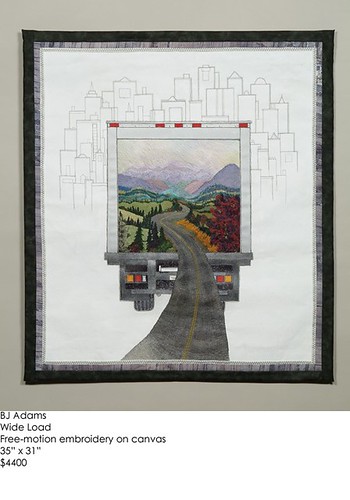
This terrific little landscape in a moving truck, by B.J. Adams, is romantic and illustrative. It says New Yorker cover to me, and that’s not necessarily a bad thing. I liked the wittiness. This time, I’m just a wee bit puzzled why this complex image would find its expression in such a slow, exacting medium.
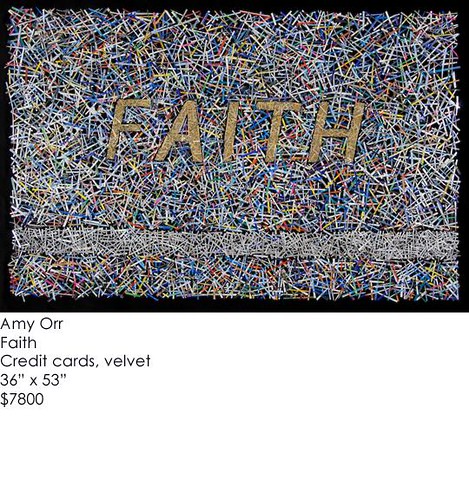
I’m ending on a local note here–Amy Orr‘s credit card shreds on velvet talk about more than just the possibility of identity theft. They talk about the American dream of spending and consumerism and our King George who is a true believer (hey, did he notice our economy is in the toilet under his reign?)
In this one, Credit Cards: Security Measures, she also pushes beyond identity theft and suggests there’s a whole underpinning of not just our economy but our entire culture in the digital world that is recording everything.
As always, Orr’s work is beautiful, smart, witty and finely crafted.
Anyway, there’s my list of fiber loves.


